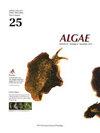基于代谢编码分析的韩国镇海湾和马山湾缺氧水域中的原生动物:强调幸存的甲藻
IF 2.4
3区 生物学
Q1 MARINE & FRESHWATER BIOLOGY
引用次数: 0
摘要
缺氧确实会影响原生生物的生存,而原生生物在海洋生态系统中发挥着至关重要的作用。为了更好地了解原生动物群落结构以及能够在缺氧水域繁衍生息的物种,我们在镇海湾和马山湾的缺氧期以及镇海湾的非缺氧期采集了表层和底层水域的样本。随后,我们利用代谢编码技术对原生动物物种进行了鉴定。在缺氧期间,金海湾和马山湾底层水域的溶解氧浓度分别为 0.8 mg L-1 和 1.8 mg L-1,在已确定的原生动物门中,双鞭毛藻门的扩增子序列变异丰富度最高。继甲藻门之后,赭藻门和纤毛虫门也有显著的表现。在镇海和马山海湾的缺氧水域中,我们共鉴定出 36 种甲藻,它们表现出不同的营养模式。其中包括 1 种自养型甲藻、14 种混养型甲藻、9 种营养模式(自养型或混养型)未定的光营养型甲藻、2 种链孢藻和 10 种异养甲藻。此外,与同一水柱内的非缺氧表层水或非缺氧底层水相比,缺氧底层水表现出更多的异养甲藻种类。因此,混养和异养甲藻的摄食可能是它们在缺氧水域中生存种类数量占优势的部分原因。这项研究不仅首次记录了 26 种在缺氧条件下生存的甲藻,而且为更全面地了解缺氧海洋环境中甲藻的生态生理学奠定了基础。本文章由计算机程序翻译,如有差异,请以英文原文为准。
Protists in hypoxic waters of Jinhae Bay and Masan Bay, Korea, based on metabarcoding analyses: emphasizing surviving dinoflagellates
Hypoxia can indeed impact the survival of protists, which play a crucial role in marine ecosystems. To better understand the protistan community structure and species that can thrive in hypoxic waters, we collected samples from both the surface and bottom waters during the hypoxic period in Jinhae and Masan Bays and the non-hypoxic period in Jinhae Bay. Subsequently, we utilized metabarcoding techniques to identify the protistan species. During hypoxia, with dissolved oxygen concentrations of 0.8 mg L-1 in Jinhae Bay and 1.8 mg L-1 in Masan Bay within the bottom waters, the phylum Dinoflagellata exhibited the highest amplicon sequence variants richness among the identified protist phyla. Following the Dinoflagellata, Ochrophyta and Ciliophora also displayed notable presence. In hypoxic waters of Jinhae and Masan Bays, we identified a total of 36 dinoflagellate species that exhibited various trophic modes. These included one autotrophic species, 14 mixotrophic species, 9 phototrophic species with undetermined trophic modes (either autotrophic or mixotrophic), 2 kleptoplastidic species, and 10 heterotrophic species. Furthermore, the hypoxic bottom water exhibited a greater number of heterotrophic dinoflagellate species compared to the non-hypoxic surface water within the same water column or the non-hypoxic bottom water. Therefore, feeding by mixotrophic and heterotrophic dinoflagellates may be partially responsible for their dominance in terms of the number of species surviving in hypoxic waters. This study not only introduces the initial documentation of 26 dinoflagellate species surviving in hypoxic conditions but also establishes a foundation for a more comprehensive understanding of the ecophysiology of dinoflagellates in hypoxic marine environments.
求助全文
通过发布文献求助,成功后即可免费获取论文全文。
去求助
来源期刊

Algae
PLANT SCIENCES-
CiteScore
5.10
自引率
25.00%
发文量
18
期刊介绍:
ALGAE is published by the Korean Society of Phycology and provides prompt publication of original works on phycology. ALGAE publishes articles on all aspects of phylogenetics and taxonomy, ecology and population biology, physiology and biochemistry, cell and molecular biology, and biotechnology and applied phycology. Checklists or equivalent manu-scripts may be considered for publication only if they contribute original information on taxonomy (e.g., new combinations), ecology or biogeography of more than just local relevance. Contributions may take the form of Original Research Articles, Research Notes, Review Articles and Book Reviews.
 求助内容:
求助内容: 应助结果提醒方式:
应助结果提醒方式:


